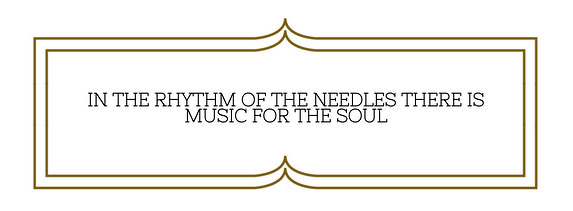"What size needle was used to knit this?"
“What size needle was used to knit this?” is a question we often hear at My Sister Knits. We put that information on the tags of display items as an indication of what size needle to use. Usually it’s the size that was recommended by the designer. It can also be the size the knitter used to get the gauge that the pattern called for. Matching stitch gauge is vital in certain circumstances! If you see something on display, fall in love with it, and want to reproduce it exactly, you’re going to need to do a little research. You want to match the stitch gauge! The knitter who created the item probably knits differently than you do. His stitches may be looser or tighter than yours. The thing you really need to know is the stitch gauge of the project! If the knitter knits more loosely than you and you use the same size needle, your project will be smaller. The opposite is also true; if that knitter knits tighter than you, your end result will be larger. This can be mildly annoying with a shawl or cowl or disastrous in a sweater. The result is possibly a garment that will lay around and be worn only seldom, if at all. This is a shame due to the time, expense, and happy anticipation you’ve put into your project.We urge you to use the needle size on the tag as a jumping-off point, as an indicator of approximately the size needle you might use.
If you see something on display, fall in love with it, and want to reproduce it exactly, you’re going to need to do a little research. You want to match the stitch gauge! The knitter who created the item probably knits differently than you do. His stitches may be looser or tighter than yours. The thing you really need to know is the stitch gauge of the project! If the knitter knits more loosely than you and you use the same size needle, your project will be smaller. The opposite is also true; if that knitter knits tighter than you, your end result will be larger. This can be mildly annoying with a shawl or cowl or disastrous in a sweater. The result is possibly a garment that will lay around and be worn only seldom, if at all. This is a shame due to the time, expense, and happy anticipation you’ve put into your project.We urge you to use the needle size on the tag as a jumping-off point, as an indicator of approximately the size needle you might use.  So what should you do about the display that you love that used a size 6 needle? Let’s say it’s a shawl. Ask us for a ruler if you don’t have one; lay the shawl out on one of our tables; find something with a point, say a darning needle or pencil, and use it to count the number of stitches over at least 2 and preferably 4 inches in a stockinette or garter stitch section. This will give you the gauge of the shawl you want to reproduce.Your task: buy the yarn you've chosen and make a knitting gauge swatch that matches the display garment’s gauge. Be sure it’s at least 4” wide and tall and give it a bath before you count your stitches per inch! If you have to go up or down a needle size and made another swatch that more closely matches, it’s ok!
So what should you do about the display that you love that used a size 6 needle? Let’s say it’s a shawl. Ask us for a ruler if you don’t have one; lay the shawl out on one of our tables; find something with a point, say a darning needle or pencil, and use it to count the number of stitches over at least 2 and preferably 4 inches in a stockinette or garter stitch section. This will give you the gauge of the shawl you want to reproduce.Your task: buy the yarn you've chosen and make a knitting gauge swatch that matches the display garment’s gauge. Be sure it’s at least 4” wide and tall and give it a bath before you count your stitches per inch! If you have to go up or down a needle size and made another swatch that more closely matches, it’s ok! If you want to get results that are even more in keeping with the display shawl, add in row gauge as well. Keep in mind that row gauge is hard to match. It would be interesting to get the shawl’s row gauge and then measure yours after you closely match the stitch gauge. Then you will have an idea of how closely your project will match the one on display!We hope to see you measuring away at the shop and we'll help in any way we can!
If you want to get results that are even more in keeping with the display shawl, add in row gauge as well. Keep in mind that row gauge is hard to match. It would be interesting to get the shawl’s row gauge and then measure yours after you closely match the stitch gauge. Then you will have an idea of how closely your project will match the one on display!We hope to see you measuring away at the shop and we'll help in any way we can! 
